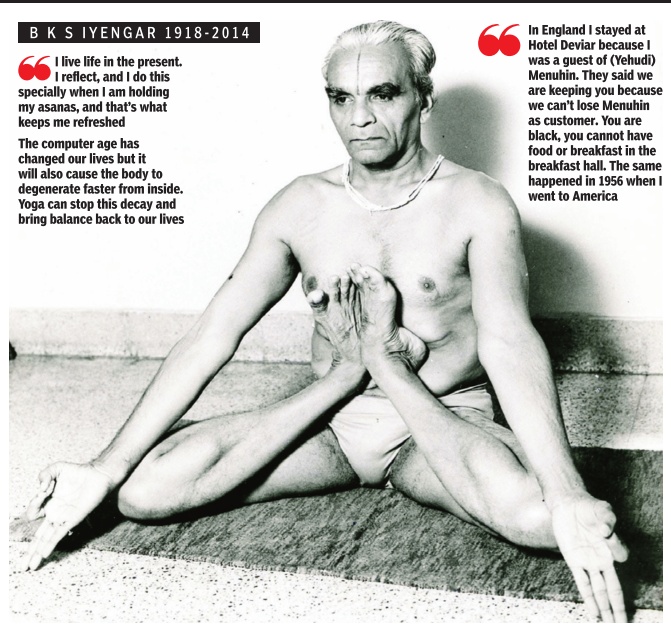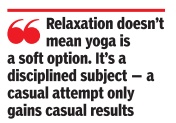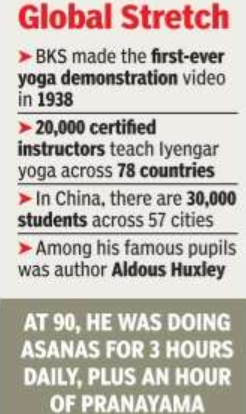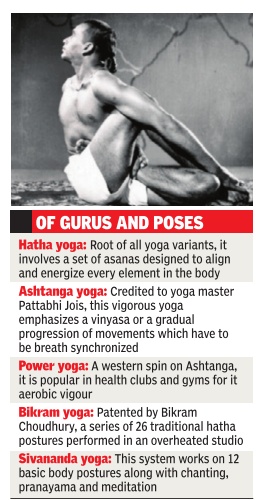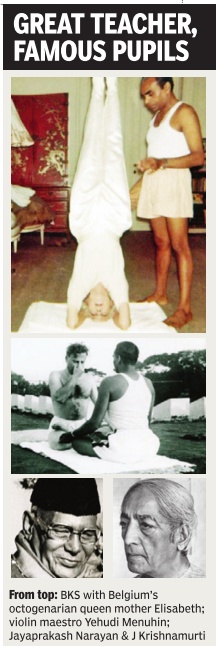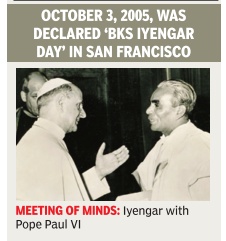BKS Iyengar
This is a collection of articles archived for the excellence of their content.
|
1
AN INCREDIBLE BODY OF WORK
Gautam.Siddharth@timesgroup.com , Inputs from Neha Madaan The Times of India Aug 21 2014
If Millions Around The World Today Swear By Yoga, Much Of The Credit Goes To B K S Iyengar And His Innovative Methods
Bellur Krishnamachar Sundararaja `BKS' Iyengar, the grand old man of yoga who could do 30-minute head stands well into his nimble nineties, began life as a sickly child; he suffered from malaria, typhoid and tuberculosis till well into his teens. “I was like a parasite,“ he once told an interviewer. “I would play one day and spend the next seven in bed. I asked myself if such a life was worth living,“ said Iyengar, who was born into a poor rural family in Bellur, Karnataka. Then his brother-in-law, the famed Tirumalai Krishnamacharya, also called the father of modern yoga, invited the boy to his Yoga Shala at the Mysore Palace. The Yoga Shala was exclusively for royals and outsiders weren't allowed but it was as if Iyengar's destiny pulled him there.
Iyengar was to later recall that the royals, being a martial people, jumped from asana to asana. “Martial people don't want philosophy; they want vanity and have a martial mindset,“ said Iyengar. So, there was the obvious problem. A person could do such a physical form of yoga till the age of, say , 40. After that it was impossible to keep up. “I changed the system. How could I tell a 68-year-old to jump and go to shirsasana?“ said Iyengar, who moved to Pune to teach yoga and stayed there until his end. He began refining the system, rediscovering the lost art of hatha yoga to recreate postures for every age. Once the body , senses, mind, intelligence, and consciousness are conquered, Iyengar would say , one has ethical and mental health. Having transcended these, one gets divine health, with health being an absence of disease.The divine life is then within.
A three-and-a-half-hour meeting with violin maestro Yehudi Menuhin in 1952 was pivotal in introducing the western world to Iyengar. While Menuhin credited Iyengar with transforming his playing, talking to Menuhin helped Iyengar reassess his own past.“I came from dire poverty . I learnt philosophy from Menuhin,“ the king of asanas once said. Soon, Iyengar was holding yoga lessons in European and American cities. Fame at home followed, and it was through the western prism that India once again saw the light of yoga. From Jiddu Krishnamurti to Jayaprakash Narayan, he taught them all. In the West, celebrities such as actor Annette Bening, fashion designer Donna Karan and writer Aldous Huxley were among his students.The guru with a trademark shock of white hair has an Oxford dictionary entry against his name as well as an entry into Time magazine's list of 100 most influential people. His book, `Light on Yoga', published in 1966, is considered a yoga bible. Iyengar's illustrious guru, Tirumalai Krishnamacharya, lived to be 100, and Iyengar -though he did poorly in school, describing himself as a “backbencher“ in his autobiography -was a more than worthy pupil, learning from him the principle: “Teach what is appropriate for an individual.“ Iyengar went on to tailor yoga according to an individual's need. He emphasized alignment in yoga which, until then, was considered a state of equanimity . “Without alignment, equanimity was impossible,“ said Iyengar. He introduced a new, accessible grammar to the lofty verses of Patanjali, making it possible for the commoner to connect with the “high“ science of yoga.
Elizabeth Kadetsky , whose wartsand-all memoir of Iyengar upset many when it released, has said it was intellectual rigour that drew her to this form of yoga. “In an Iyengar class the level of language is so articulate and smart.... In that way Iyengar has affected the world of yoga by giving it a level of serious professionalism and discipline,“ she said in an interview.
The influence went as far as China, where “Guruji“ acquired a considerable following, and even got a stamp in his honour. Yoga, he felt, could bring the two countries together. “I have created friendship through yoga,“ he told his Beijing audience. “If you practise yoga, your way of thinking becomes different. If you stand on your feet, you see the world one way . But if you are standing on your head, and are topsy-turvy , the world will look a whole lot different.“
2
BKS NEVER LIKED THE TERM IYENGAR YOGA - `Yoga is not a Hindu preserve, it's for all'
The Times of India Aug 21 2014
In 2011, BKS Iyengar travelled to Beijing to preside over a yoga summit. Here are excerpts from an interview he gave to TOI on the eve of his last trip abroad: .
East vs West... I find that the East absorbs yogic philosophy far better. Yoga is an emotional subject and in the West, they calculate from the head while the East banks on the intelligence of the heart. They are both strong in their own spheres. But I find that nations which are geographically centred in the world map -such as Russia and Africa -have the best of both approaches.They use the head as well as their heart to their advantage. Yoga teaches us to move from Kurukshetra to dharmakshetra and god knows we need fewer Kurukshetras today! Yoga not just for Hindus... Yoga is an Indian heritage, not a Hindu property . .
Patanjali's Yoga Sutra, which forms the basis of the system, addresses all humanity not just Hindus. Just because yogis did not travel as widely as they do today does not imply that the practice belonged to one community or place. Patanjali calls yoga sarva bhauma, a universal culture.On yoga being marketed purely as a fitness regimen... The fact is that yoga is open to interpretation. For instance, Patanjali talks of sexual yoga and if someone decides to reduce yoga to just that what can one do? I can't blame people for exploiting its open-endedness..
On teaching the Chinese... The Chinese have for centuries been practising physical regimens that have spiritual connections. They have the concept of yin and yang, which is parallel to what we call ida (consciousness ) and pingala (self). It will be easy to connect with the Chinese on these. There are many yoga practitioners in China today . I mean to show them how to start from scratch and aim for the ultimate.Asana and pranayama are perceivable aspects of yoga, but there are other layers which are not that obvious.These connect yoga to our life, our spiritual and moral health. Few talk about these aspects anymore.
3
Young or old, everyone's on the mat in this class Malini.Nair@timesgroup.com The Times of India Aug 21 2014 In an overheated, billion-dollar market, Iyengar yoga stands apart, with its no nonsense, classicist approach. The guru smashed the weird-contortionist-twist ed-around-himself cliche to create a scientific system for yoga. Iyengar is credited with some breakthrough ideas that form the bedrock of yoga practised in the world today .
Anyone can do yoga There is no premium on being fit, flat-abbed or flexible in an Iyengar class. Iyengar believed yoga was as much for the ageing and sick as for the young and healthy . The techie with a stiff neck, the middle-aged mother with flabby triceps, the senior citizen with a shuffle, for Iyengar, no one was beyond yoga. In his class you could see as many imperfect bodies gasping to reach their toes as agile youngsters who could drop back with ease. The idea was never to strike the perfect pose, it was to do it mindfully. In classes, the limber women in lycra were often told to watch how intelligent ly and strongly the grandmother in bloomers worked her back quadriceps in uttanasan, the toe touch. You learnt that a sagging stomach, thick knees and fat calves taught you to use the body mindfully . The Iyengar props -which many yoga schools sneered at but then co-opted -bolstered this belief. It allowed the nervous 60-year-old to go into a headstand, reassured that the rope held her hip in place. The wooden brick brought every forehead to the ground in the downward dog; the wooden trestle let the body the right to a perfect forward bend.
First body, then mind Cross-legged navel gazing of the kind that assorted lifestyle gurus teach is never a part of the Iyengar practice. The guru believed that if you cannot sit still without the knee complaining, the spine dropping or the neck tilting -you had no business meditating. To centre the mind, the body had to be centred and that came with the rigour of physical practice. Once you cracked bodily stillness only then could you think of moving into higher realms. With him, pranayama came at the end of every session when the body was pliant and quiet. Contrary to other schools, Iyengar never believed in the pure pranayama class without an asana preface. In fact, for him, working towards a pure pose was an act of meditation.Align, align, align Iyengar yoga has minimal movement. The goal is to strive for perfect body alignment, the Vitruvian man as Patanjali saw it. The standing pose, tadasana, was Iyengar's favourite for its emphasis on alignment.
His instructions were micro-managed to achieve this. Even surya namaskar, used as an aerobic warm up by others, was a slow series of movements, each of which had to be just so before you could move on.
